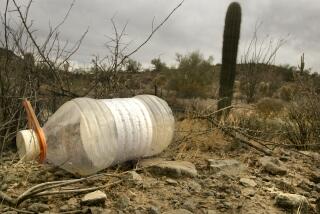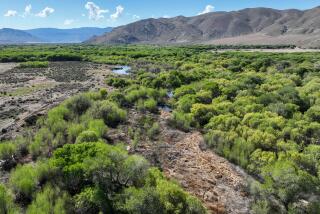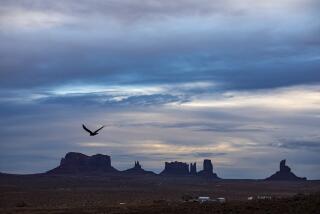In Defense of the Earth’s Hydrosphere
“No man may abuse a well,” says the Koran. If only humanity had followed that wise decree.
Instead, we enter a new millennium with a gravely imperiled hydrosphere. More than 1 billion people have no access to clean drinking water; nearly 3 billion live without sanitation. Politicians and generals increasingly play the water card in border disputes. From Egypt to Brazil, China to Libya, Uzbekistan to the U.S., water, its uses and misuses, looms as the critical issue of the dawning century, according to Canadian author and journalist Marq de Villiers.
“Water: The Fate of Our Most Precious Resource,” a rich, readable survey of the subject, draws upon personal anecdote, the author’s keen grasp of his subject, wide travels to regional flash points in the water debate, and interviews with leading experts to examine “the wholesale assault our species is making on the system that sustains us.”
Staggering figures marshal our attention. Global water demand tripled between 1950 and 1990 and is expected to double again in the next 25 years. According to a World Commission on Water report, more than 25 million people are refugees as a direct result of river pollution. The water problem is a multi-headed Hydra: shrinking aquifers, ill-placed dams, greenhouse emissions, polluted ground tables, desertification (“You cannot sweep back the Sahara with a broom,” laments an official in Mali). In parts of Eastern Europe, rivers run yellow with industrial pollution. The Aral, once the world’s fourth largest lake, is now mostly desert. Africa’s Lake Chad is sinking 100 feet a year. Arctic ice has thinned by 40% in four decades.
Closer to home, the imminent exhaustion of the Ogallala Basin aquifer threatens to destroy the agricultural economy of eight central U.S. states. The Colorado River Basin Project provides water for 30 million people, generating electricity for the Las Vegas strip and filling Southern California swimming pools, while reaping ecological havoc en route (saline farmlands, the probable closure of Glen Canyon dam).
Water scarcity and misuse incite age-old tribal and national antipathies, turning water into a weapon of war. “Downstream problems,” De Villiers points out, “are not always solvable if upstream is in another country.” Turkey is upstream, Israel and Syria and Iraq downstream; Angola is upstream, Namibia downstream. Egypt, downstream, has threatened war if Ethiopia, upstream, withholds the Nile’s waters.
But “Water” is more than an alarmist litany of scary facts. De Villiers examines the rehabilitation of the near-fatally polluted Rhine River, intensive waste-water re-use programs in Egypt and Israel, seawater conversion (Saudi Arabia produces 485 million liters a day from desalinization) and other possible solutions ranging from the potentially viable to the downright quirky: genetically engineered crops, towing icebergs, dew collecting, cloud seeding, water hauling, long distance water piping (California and Libya already do it). Still, impending “water stress” makes some kind of worldwide water management a likely necessity. Global agencies are already drafting rationing plans for drinking water, sanitation, bathing, food preparation. Reading about water can be, paradoxically, dry, but De Villiers does an excellent job of rendering his oceans of data digestible. Lucid and thorough, “Water” is a good place to tap into this subject, vast as the spreading Sahara yet intimate as your dripping kitchen faucet. “There is no ‘them’ doing this,” De Villiers points out. “We’re all at fault.” When it comes to the water question, the ecologists’ motto has it right: We’re all downstream.
*
Tony Cohan is the author of “On Mexican Time.”
More to Read
Sign up for Essential California
The most important California stories and recommendations in your inbox every morning.
You may occasionally receive promotional content from the Los Angeles Times.










